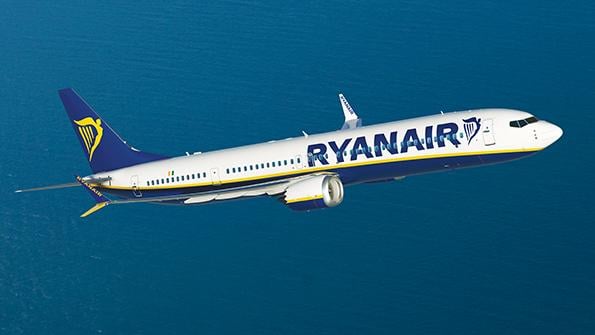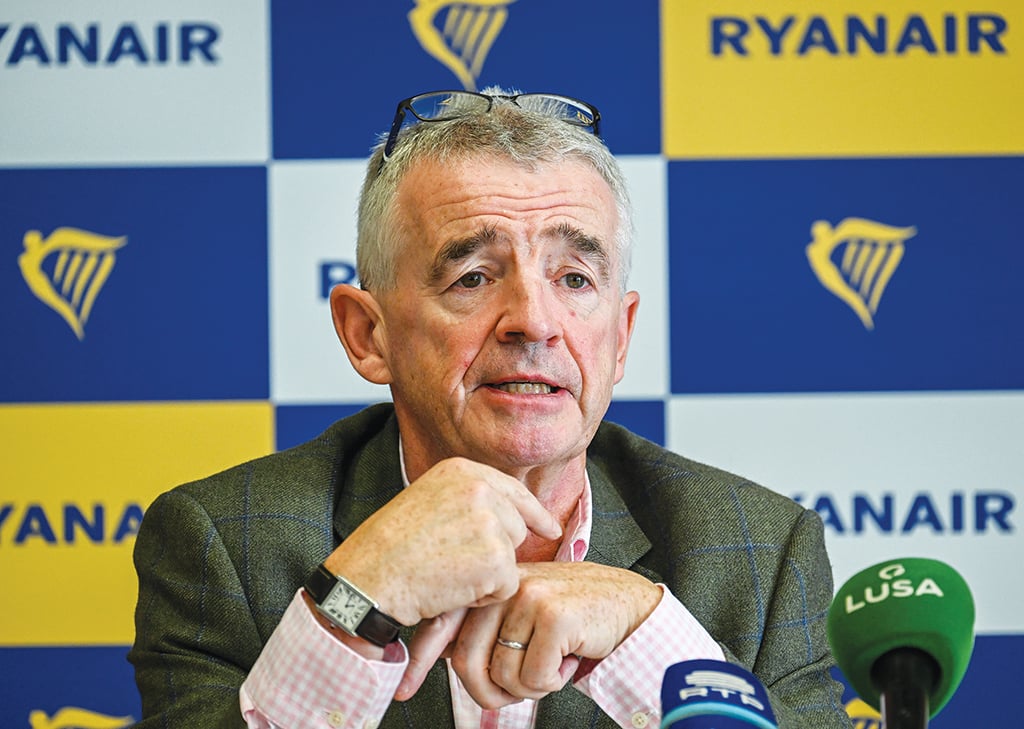
Ryanair placed a firm order in May for 150 Boeing 737 MAX 10s, with 150 options.
Michael O’Leary joined Irish LCC Ryanair as CFO in 1988 and became CEO in 1994. This means he has headed Ryanair for 29 years, making him one of Europe’s longest-serving airline leaders as well as one of the most characterful with his penchant for direct talk and pithy punchlines.
As Ryanair Group CEO, O’Leary appears to be setting the scene for less influence over the company—his contract expires in 2028—while also reflecting on what he has done right in building the astonishing success of Ryanair and what may not have worked out as planned.
For one, O’Leary now acknowledges that the group’s multi-air operator’s certificate (AOC) strategy “hasn’t developed much” since it was launched in 2017. And while he hinted that there may be some small “add-ons,” Ryanair will not be participating in large-scale acquisitions, like its historic Lauda deal and thwarted Aer Lingus bid.
Talking about the multi-AOC strategy during an earnings call, O’Leary said, “It’s not something we would have done by choice; it was a practical response to a number of issues and challenges we were facing, primarily post-unionization in 2017.”

O’Leary explained that the Irish government wanted to levy a local tax on Irish-registered aircraft crews, whereas the newly recognized unions wanted employment contracts and taxation where they were based. “The AOCs facilitated that,” he said.
Today, Ryanair Group comprises five AOCs: Ryanair
DAC is the original Irish LCC; Ryanair UK was set up in response to the UK’s exit from the European Union (Brexit); Lauda Europe was acquired as an Austrian airline and later transferred to a Maltese AOC; Buzz—formerly known as Ryanair Sun—has a Polish AOC to give it route rights to non-EU leisure destinations in Egypt and Turkey; and Malta Air was formed as a joint venture with the Maltese government in 2019.
“It adds a little bit of complexity, particularly on the management side, but I think it’s a sensible way forward,” O’Leary said, noting that this mirrors similar models used by Lufthansa Group and International Airlines Group (IAG).
When Ryanair Holdings was established in 2019, O’Leary said this umbrella company would give Ryanair group-level resources to study acquisitions and growth opportunities as they arose. However, speaking on the earnings call, O’Leary said large mergers and acquisitions (M&As) were “highly unlikely.”
“We tend to avoid large-scale M&As. You’re generally inheriting somebody else’s problems and, given our size, it is very easy for the legacy carriers like Lufthansa, Air France and BA to mobilize and lobby against Ryanair M&As,” he said. “And, with the aircraft orders we have in place now, we can grow organically to 300 million passengers a year. Frankly, I don’t really see why we would want to engage in M&As.”
Ryanair’s two airline acquisitions—KLM’s UK-based regional airline Buzz—which held 10%-15% of the slots at London Stansted—in 2003 and Vienna-based Lauda in 2018 “were bloody painful experiences,” O’Leary said, but they ultimately helped Ryanair build up “very strong positions” at Stansted and Vienna.
“We don’t have management resources to just deploy into large scale M&As. We might do some smaller stuff, kind of ‘add-ons,’ but they’ll be very small and, I would say, insignificant,” he said.
EUROPEAN CONSOLIDATION
In his usual bullish style, O’Leary said M&As will be “the only way” for rivals to compete with Ryanair’s expansion.
“I continue to believe that in the medium-to-longer term Europe will consolidate into four very large airline groups, which will be Lufthansa, Air France-KLM, IAG and us,” he said.
He listed easyJet, Norwegian, Scandinavian Airlines (SAS) and Wizz Air as potential targets of European consolidation, following on from ITA and TAP Air Portugal, which both have sales processes “actively underway.”
“EasyJet is clearly a target for consolidation,” O’Leary said. “And ultimately somebody will have a look at Wizz. If it’s not Lufthansa re-establishing some eastward operations, their [Wizz’s] expansion into the Middle East may well encourage an investment from Middle East owners, who are all talking a big story about airline growth, but [they are] constrained by capacity. Wizz at least has access to aircraft … and they will be far better deployed in the Middle East.”
Moving into summer 2024, O’Leary believes the European market will return to 100% of pre-pandemic capacity, but for now he sees short-haul capacity constraints, giving airlines pricing power.
“There’s a large backlog of aircraft deliveries, and we believe that’s going to continue to constrain capacity growth in Europe for at least the next three or four years,” O’Leary said. “And [that] will assist us as we continue to expand our fleet. I think we’ll see growth with strong traffic demand, and I would hope to see modest airfare rises over the next two or three years.”
O’Leary reckons that capacity constraints and shortages of both new and used aircraft could continue out to 2030, but there will be bumps in the road between now and then.
“There’ll be another crisis between now and 2030,” he said. “I just don’t know when or what it’ll be or where it will come from.”
Operational resilience is another challenge for European operators, but O’Leary is managing this through additional crews and by doubling operations control center capacity in Dublin and Warsaw. O’Leary believes Europe’s air traffic control problems will ultimately be sorted out, but extra standby crews will be needed for “the next two or three years” to avoid ATC-related flight cancellations.
LAB WORK
Ryanair DAC CEO Eddie Wilson said the Dublin-based Ryanair Labs technology center has been “particularly important,” because situations that would have resulted in operational “meltdown days” five or six years ago can now be managed in real-time.
“Optimizing the allocation of crews has been critical, not just piling extra bodies in. The support and systems that we have are homegrown systems and they are working very effectively this summer. We are able to get through without cancellations, unlike many of our competitors,” he said.
Ryanair Labs employs nearly 1,000 people. Its main focus is IT infrastructure and cybersecurity, but about half is split between revenue development and operations management. Wilson said operational technologies will come “more in focus” as the Boeing 737 MAXs start to arrive.
“We’re not going to be able to add people on at the head office level to support that in a linear fashion,” he said.
The airline has just placed an order for 150 737 MAX 10s, with 150 options, paving the way for significant expansion through to the mid-2030s. Ryanair is planning to grow from 149 million passengers in 2019 to 225 million in 2026, hitting 300 million by 2033-2034.
Work is underway to develop “all sorts of support systems” for Ryanair’s pilots, cabin crews and engineers, including e-tech logs and personal electronic devices to communicate any last-minute changes to pilots and cabin crew. Ryanair Labs can also “run resilience on rosters,” and make changes in real-time. “You’ve got to solve the problems before they happen,” Wilson said, “so we don’t have to hire a large amount of people as we grow to 300 million passengers.”
O’Leary recalled how Ryanair used to buy airline computer systems from larger airlines like Lufthansa. At the time, Ryanair carried around 5 million passengers a year, while Lufthansa’s annual passenger total was 40 million. The tables have now turned, with Ryanair carrying around 200 million, and Lufthansa—Europe’s next-largest airline group—handling around half that number.
“The challenge for us going forward is that nobody has developed systems for an airline that now has nearly 200 million passengers, with a plan to go to 300 million passengers, so we have to do it ourselves,” he explained. “The way that [Ryanair] Labs has exploited ancillary revenues in the last few years has really been visionary. Bringing that in-house and developing those systems ourselves has been, I think, one of the great sea changes in our development over the last decade.”
Meanwhile, Ryanair’s competitors have been experiencing “very significant challenges” from “tacked on” legacy systems that “don’t talk to each other.”
Ryanair has prepared itself for significant future growth, but the question remains whether O’Leary will continue to lead the group beyond the expiry of his current contract in 2028.
“Increasingly, whether the board wants me to extend my contract in 2028 or not, is frankly immaterial,” O’Leary said. “This business is no longer heavily dependent on me. In the early days, I used to make all the decisions in Ryanair. Increasingly, I make very few decisions in Ryanair because it’s such a big operation,” he said.”





